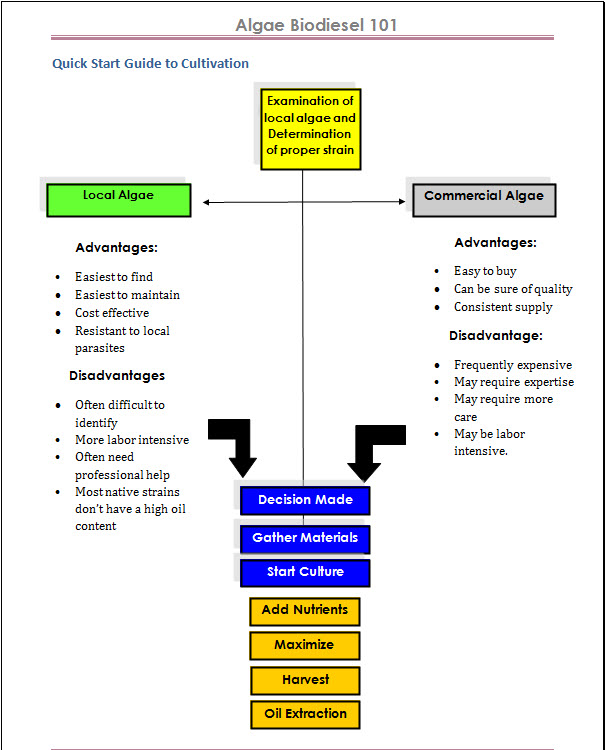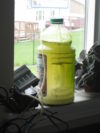
The basic algae biodiesel process is fairly straight forward:
There are six basic steps in the algae biodiesel process.
- Chose the proper algae strain for your climate and situation
- Grow your algae
- Test and maximize production
- Harvest your algae
- Extract the oil
- Process into biofuel or biodiesel.
The devil however is in the details. :+) Each step in the process chain must be done correctly to arrive at a finished result.
Is it simple? Yes, once you know the correct inputs.
Is it difficult? No. But there is trial and error involved.
Is it easy? Nothing is easy in the beginning, but it gets better as you go along and more information is gained.
Here is the algae biodiesel process in a nutshell:
Step 1: Locate and identify native strains
- See if local algal strains fit with your product/co-product mix
- If they do (Rare, but it happens) start growing strains in algae incubator
- If not, research and identify algal strains to DO fit with your product/co-product mix
By the end of this phase you should know the local algae in your area, if they can produce biofuels (Biodiesel or bioethanol) and what co-products they are conducive to creating, and how much pf a profit stream you can generate.
Step 2: Grow your algae

- Buy strain and start growing in incubator
- Study the growth dynamics. Watch the complete life cycle. Pay special attention to the time it is first introduced, and it starts its "exponential" growth phase.
- Pay special attention to the time from when "exponential" phase ends and the die off begins. (Harvest)
By the end of this phase you should know how fast your algal strain grows at, when the best time to harvest is, what to expect growth-wise.
Step 3: Test and maximize production

Build a test bioreactor (Download one here free on the bioreactor page)
- Start testing different nutrients
- Test different lighting regimens
- Target: = 50 grams/per gallon/per day
By the end of this phase you should know what can be achieved under ideal conditions.
Step Four: Harvest:

Experiment and test different harvesting methods.
- Some methods work better than others depending on strain and size of micro algae chosen.
- You'll have investigated various inexpensive methods of algae harvesting and decided on the one which makes the most sense in your situation.
Step Five: Oil Extraction

You've harvested the algae and dried it. Now is the time to see if enough viable oil can be extracted from it.
- You'll research inexpensive methods of algae oil extraction.
- You will have extracted algae oil
Step Six: Process into biodiesel or bio ethanol
It is in this section algae biodiesel process all comes together and you start making top quality fuel you can use.

By the end of this book, you'll be able to know

- The algae strain you've chosen
- It's main products and co-products
- How well, and how fast it grows
- The best methods for growing algae
- The best light regimens
- The best nutrients to use
- How much you can grow under ideal conditions
- The best methods of harvesting the algae
- The best method for algae oil extraction
- Be able to extrapolate the amount of algae you'll need to grow and harvest to meet your needs.
- Whether you need to use a algae bioreactor of raceway pond to meet your needs.
- The best method to use for harvesting
- The best techniques for oil extraction
- How to process into fuel you can use.
You might also be interested in...

The Algae Biodiesel Process
The algae biodiesel process is fairly straight-forward, however the devil is in the details. Read More

The Two Biggest Mistakes in Algae Biofuels
Without a doubt, The Two Biggest Mistakes I saw as a biofuel consultant in advanced biofuels were...Read More

Algae Biofuels: Separating Myth From Fact
Lot so wild stories and wild claims being made in the algae biofuels space. Sifting through the flotsam of cyberspace isn't easy... Read More
The Algae Revolution Has Begun
David thanks again for your insightful view on Making Algae Biofuels Book a subject that is set to change the world for the better. And with this in mind I invite anyone with the hunger to know more about algae biofuels to put this book on your must read list immediately.




